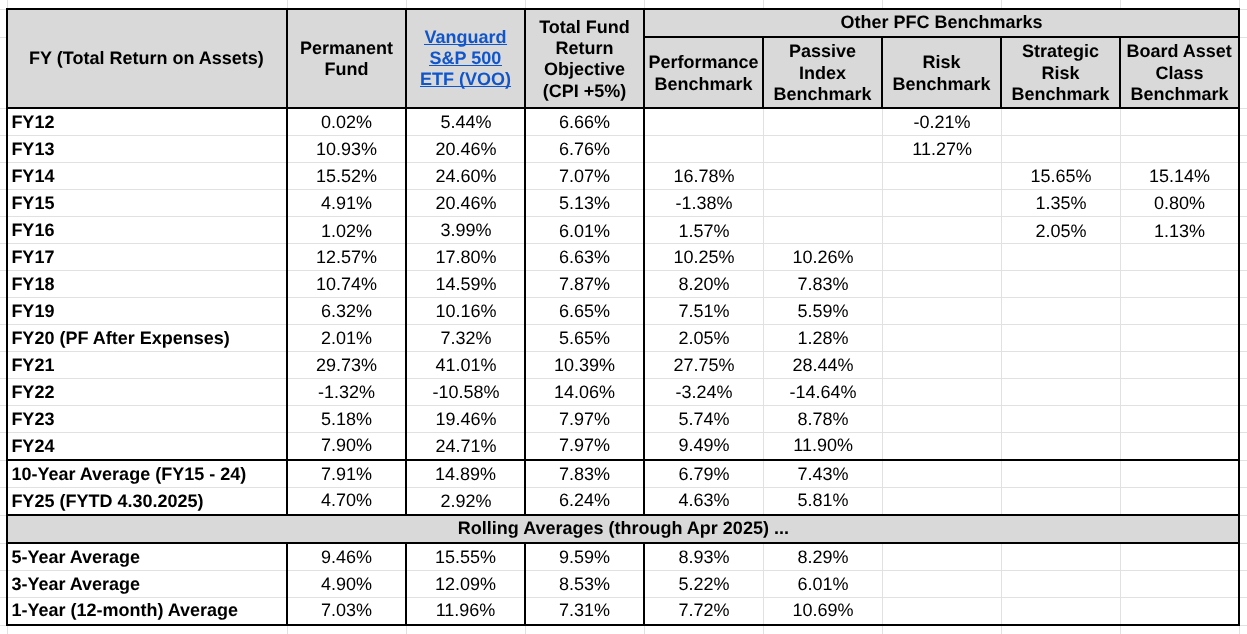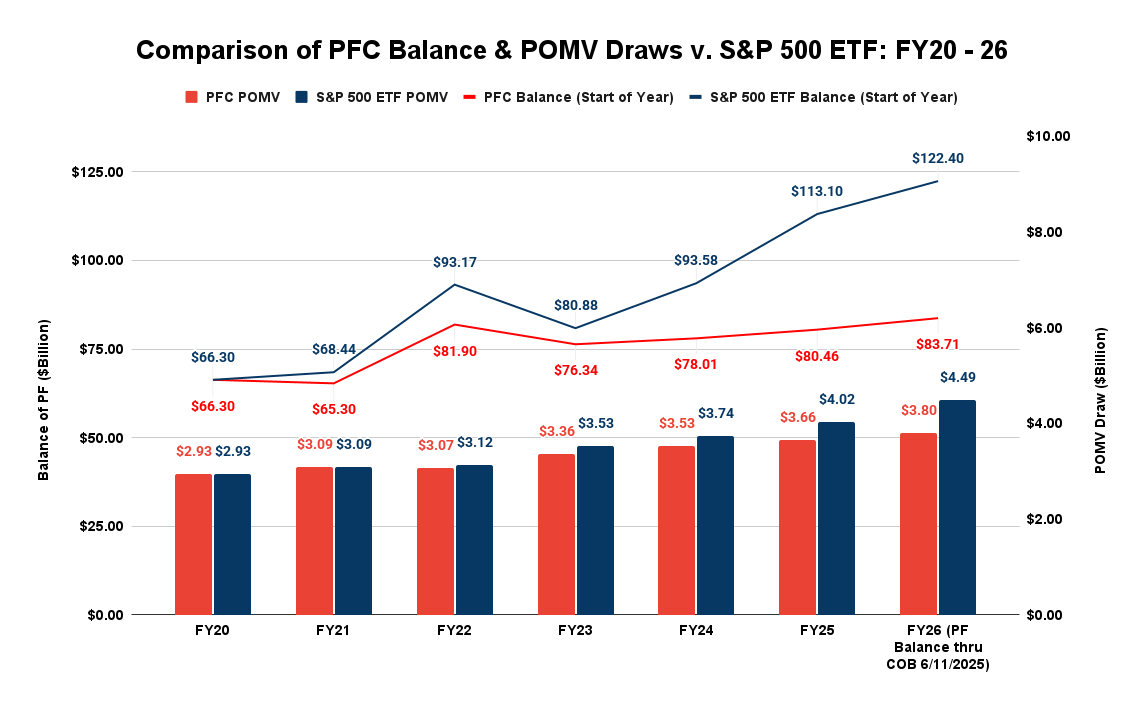As regular readers will know, we have written several times in recent months about the performance of the Permanent Fund Corporation (PFC) in managing the Permanent Fund (Fund). A number of those columns have focused on the financial returns the PFC is achieving.
As we have continued to dive deeper into the issue and discussed it with others, we have become increasingly concerned about the management and investment approach taken by the PFC. As we have explained in previous columns, we believe that the PFC’s approach is both much too cautious and much too costly, which has resulted in the PFC leaving a significant amount of money on the table when measured against even its own self-selected benchmarks.
In evaluating the PFC’s performance, we have also looked at relatively well-known and lower-cost alternative investment approaches that, if implemented, would help achieve significantly higher financial returns, driving the balance of the Permanent Fund to considerably higher levels. Because they are based on Fund balances, increasing those balances also would increase the amount of the percent of market value (POMV) draws used annually by the state to fund Permanent Fund Dividends (PFD) and pay for a portion of unrestricted general fund (UGF) spending.
In short, achieving higher returns and, through them, higher balances would result in higher PFDs and in more revenues for government services.
As we have explained in another column, for that reason, we believe that the PFC’s performance in managing the Fund very likely could become a significant issue in next year’s election cycle, especially in the governor’s race. Because, either through cabinet appointments or directly, the governor appoints all of the members of the PFC’s Board, we believe candidates’ views toward what they expect of board members and their management of the Fund will become highly relevant during the coming election cycle.
Because of its poor performance, we and others have also pushed for significant reform of the board. Because that will require legislative action and subsequent oversight, we believe the issues will also potentially reach into the state Senate and House races.
An article in this week’s Anchorage Daily News (ADN) on the Fund’s performance mentions none of that. Instead, it reads more like a lightly edited public relations release from the PFC praising its own performance.
The article is built around the PFC’s claim that the Fund’s value reached an “all-time high” last week. That may be true on an unaudited basis, especially if not adjusted for inflation. As of the day this column is being written, the PFC’s website reports a “Daily Market Value” (unaudited) of $83.7 billion.
But that is not remotely what the value of the Fund would be currently if the PFC were using other, less costly, and less overly cautious investment approaches.
To understand why, it’s important to look at the returns the PFC has recently been achieving compared to its own benchmarks as well as compared to the returns that are achievable using alternative investment approaches.
Here are the returns applicable under various approaches since FY2012. Those for the Permanent Fund, the PFC’s “Total Fund Return Objective” and the “Other PFC Benchmarks” are taken from the PFC’s own fiscal year ending “Monthly Performance Reports.” Those for the “Vanguard S&P 500 ETF” (exchange-traded fund) are taken from industry-standard TotalRealReturns.com for the Vanguard-managed S&P 500 ETF, a relatively well-known and significantly lower-cost investment approach.
These are the results through April 30, 2025, the last month for which the PFC has posted complete results.

While the PFC generated returns appear competitive against the Total Fund Return Objective and the other self-selected PFC benchmarks on a 10-year average (through the end of FY24) and rolling 5-year rolling average, they are much lower than all of the PFC benchmarks on the more recent 3-year rolling average and, while somewhat less so, still lower than all of the PFC benchmarks compared to the most recent 1-year rolling average.
More significantly, the PFC-generated returns are substantially lower across all full-year periods than the alternative, and significantly lower-cost approach of investing the Fund in an S&P 500 ETF. The differences for the 10-, 5-, 3-, and 1-year rolling averages range from approximately 4.9% to 7.2%, all significant percentages. While the PFC-generated return for the 10-month period through the end of April 2025 was higher by around 1.8%, the fiscal year to-date S&P 500 ETF return has since bounced back to 9.39% as of the end of May, and as of same day on which the ADN article was published (June 10), to 11.9%.
While the PFC won’t publish its returns through the end of May until later this month, based on the relative rise in the PFC balance over the period, it is unlikely that the PFC’s return for the same period will be any higher than the 7% return posted for the rolling 12-months as of the end of April.
What do the differences in returns mean in terms of Fund balances and POMV levels?
To evaluate that, we have compared what the Fund balances and POMV levels were under the PFC’s approach versus what they would have been had the Fund been reinvested in an S&P 500 ETF on the first day of fiscal year 2020, the first full year after Governor Mike Dunleavy (R – Alaska) was elected to his first term. Here’s the result:

The differences are stark. Rather than the $83.5 billion extolled in the ADN article, or even the $83.7 billion balance based on the PFC’s own most recent estimate, the value of the Fund would be approximately $122.4 billion, an increase over current levels of nearly $40 billion (or over 45%) just since the beginning of FY20.
And even though, because of the lag built into the POMV formula, differences in the POMV levels produced by the two approaches would not have started until FY22, two years after the switch, the amount of the POMV draw under the S&P 500 ETF approach would already be nearly $700 million ($3.8 billion v. $4.5 billion, or more than 18% larger) than under the PFC’s approach. To put that in perspective, that difference alone is larger than our most recent estimate of what could be achieved annually through oil tax reform.
Looked at another way, divided 50/50 between the PFD and government services, that difference alone would cause an increase of over $1,000 per PFD, or about $2,630 per average-sized Alaska household this coming year.
We understand why the PFC pushed, and the ADN wrote a puff piece on the PFC’s performance. Even if based on unaudited projections, the PFC wants to use any opportunity it can to claim success in its approach.
But one of the purposes of a newspaper is to put the news, especially one that ends up being the lead article, as was the ADN’s piece about the Fund, in a meaningful context. Here, the context is that, as good as some claim the PFC’s performance is, the Fund’s performance still lags not only the PFC’s own self-selected benchmarks but also other relatively well-known and lower-cost investment approaches.
In short, as good as the POMV draws from the PFC’s approach seems to be, they could be much, much better, with significant positive effects on both PFD levels and state budgets.
As we have explained in a previous column, that issue has the potential to play a significant role in the upcoming election cycle. The sooner the ADN and other news sources start educating Alaskans on it, the better off the state will be.
Brad Keithley is the Managing Director of Alaskans for Sustainable Budgets, a project focused on developing and advocating for economically robust and durable state fiscal policies. You can follow the work of the project on its website, at @AK4SB on Twitter, on its Facebook page or by subscribing to its weekly podcast on Substack.






But the people of Alaska eligible for the Permanent Fund Dividend will never see any of these gains. The Legislators in Juneau have decided (since 2016) to take more from the earnings of the Fund and in 2025 15% is “good enough” for the people and 85% of the earnings is what belongs to the State for running the government. I have even done a better job of investing my money at 1, 3, and 5 year averages than the Alaska Permanent Fund at investing: 10.49%, 13.29% and 15.29% respectively using the State’s own EMPOWER retirement fund limited choices for… Read more »
For those interested, Larry Dietrick has added an excellent supplement to this column, rich in detail about the PFC’s current investment approach, in the comments section to where this week’s column appears on our Substack pages. The link to his comments is here: https://substack.com/@larrydietrick1/note/c-125723322?utm_source=notes-share-action&r=ez918.
We encourage those interested in an even deeper dive into this subject to read there.